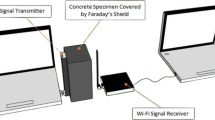Abstract
Concrete durability is to a large extent governed by the concrete resistance to the penetration of aggressive substances. One such aggressive substances, present predominantly in marine or coastal environments, is the chloride ion. Chloride in presence of water and oxygen cause corrosion and the measurement of chloride content is an important factor in the detection of early corrosion damage induced by chloride attack. However, there is currently a lack of a reliable nondestructive method to examine the chloride content of the structure in practice. This paper presents the results of an experimental study to investigate the viability of Microwave Non-Destructive Testing (MNDT) to monitor the ingress of the chloride into the concrete. The variations in the electromagnetic properties of mortar specimens with variations in their chloride contents are measured to identify correlations between chloride content and two main electromagnetic properties of mortar; viz. dielectric constant and loss factor. EMPs are measured through two-port measurement performed using a vector network analyzer and S-band rectangular waveguide. The existence of correlations between chloride content of mortar and its electromagnetic properties is confirmed by the preliminary results, highlighting the potential for development of an MNDT technique to monitor the chloride content of concrete in practice.
Access this chapter
Tax calculation will be finalised at checkout
Purchases are for personal use only
Similar content being viewed by others
References
Alonso, C., Andrade, C., Rodriguez, J., Diez, J.M.: Factors controlling cracking of concrete affected by reinforcement corrosion. Mater. Struct. 31(7), 435–441 (1998)
Andrade, C., Alonso, C., Molina, F.: Cover cracking as a function of bar corrosion: part I-experimental test. Mater. Struct. 26(8), 453–464 (1993)
Angst, U., Elsener, B., Larsen, C.K., Vennesland, Ø.: Critical chloride content in reinforced concrete—a review. Cem. Concr. Res. 39(12), 1122–1138 (2009)
Australian Standards: AS 3972 general purpose and blended cements (2010)
Bartley, P.G., Begley, S.B.: A new technique for the determination of the complex permittivity and permeability of materials. In: 2010 IEEE Instrumentation and Measurement Technology Conference Proceedings (2010)
Berg, A., Niklasson, G., Brantervik, K., Hedberg, B., Nilsson, L.O.: Dielectric properties of cement mortar as a function of water content. J. Appl. Phys. 71(12), 5897–5903 (1992)
Broomfield, J.P.: Corrosion of Steel in Concrete: Understanding, Investigation and Repair. CRC Press, Broomfield (2002)
De Zaeytijd, J., Maes, T., Franchois, A.: 2-D real-time quantitative microwave imaging of reinforcement bars: simulations and experiments. In: International Conference on Electromagnetics in Advanced Applications, ICEAA 2007. IEEE (2007)
Hausmann, D.: Steel corrosion in concrete–how does it occur? Materials protection (1967)
Isgor, O.B., Razaqpur, A.G.: Advanced modelling of concrete deterioration due to reinforcement corrosion. Can. J. Civ. Eng. 33(6), 707–718 (2006)
Kharkovsky, S., Zoughi, R.: Microwave and millimeter wave nondestructive testing and evaluation-overview and recent advances. IEEE Instrum. Meas. Mag. 10(2), 26–38 (2007)
Kharkovsky, S.N., Akay, M.F., Hasar, U.C., Atis, C.D.: Measurement and monitoring of microwave reflection and transmission properties of cement-based specimens. IEEE Trans. Instrum. Meas. 51(6), 1210–1218 (2002)
Kim, S., Kang, J., Lee, S.-H., Ahn, Y.H.: Effect of chlorides on conductivity and dielectric constant in hardened cement mortar: NDT for durability evaluation. Adv. Mater. Sci. Eng. 2016 (2016)
Kwon, S.-J., Feng, M.Q., Park, S.S.: Characterization of electromagnetic properties for durability performance and saturation in hardened cement mortar. NDT&E Int. 43(2), 86–95 (2010)
Melchers, R.E., Li, C.Q.: Phenomenological modeling of reinforcement corrosion in marine environments. ACI Mater. J. 103(1), 25–32 (2006)
Nilsson, L., Poulsen, E., Sandberg, P., Sorensen, H., Klinghoffer, O.: Chloride Penetration into Concrete State of the Art. The Danish Road Directorale, Copenhagen (1996)
Ong, K.G., Akbarnezhad, A.: Microwave-Assisted Concrete Technology: Production, Demolition and Recycling. CRC Press, Boca Raton (2014)
Rhim, H.C., Buyukozturk, O.: Electromagnetic properties of concrete at microwave frequency range. ACI Mater. J. 95(3), 262–271 (1998)
Rodriguez, J., Ortega, L., Casal, J.: Corrosion of reinforcing bars and service life of reinforced concrete structures: corrosion and bond deterioration. In: International Conference on Concrete Across Borders, Odense, Denmark (1994)
Vidal, T., Castel, A., François, R.: Corrosion process and structural performance of a 17 year old reinforced concrete beam stored in chloride environment. Cem. Concr. Res. 37(11), 1551–1561 (2007)
Wen, S., Chung, D.: Effect of admixtures on the dielectric constant of cement paste. Cem. Concr. Res. 31(4), 673–677 (2001)
Win, P.P., Watanabe, M., Machida, A.: Penetration profile of chloride ion in cracked reinforced concrete. Cem. Concr. Res. 34(7), 1073–1079 (2004)
Yoon, S., Wang, K., Weiss, W.J., Shah, S.P.: Interaction between loading, corrosion, and serviceability of reinforced concrete. Mater. J. 97(6), 637–644 (2000)
Zhu, W., François, R., Fang, Q., Zhang, D.: Influence of long-term chloride diffusion in concrete and the resulting corrosion of reinforcement on the serviceability of RC beams. Cem. Concr. Compos. 71, 144–152 (2016)
Author information
Authors and Affiliations
Corresponding author
Editor information
Editors and Affiliations
Rights and permissions
Copyright information
© 2018 Springer International Publishing AG
About this paper
Cite this paper
Chiniforush, A.A., Noushini, A., Akbarnezhad, A., Valipour, H. (2018). Detecting the Presence of Chloride in Hardened Mortar Using Microwave Non-Destructive Testing. In: Hordijk, D., Luković, M. (eds) High Tech Concrete: Where Technology and Engineering Meet. Springer, Cham. https://doi.org/10.1007/978-3-319-59471-2_11
Download citation
DOI: https://doi.org/10.1007/978-3-319-59471-2_11
Published:
Publisher Name: Springer, Cham
Print ISBN: 978-3-319-59470-5
Online ISBN: 978-3-319-59471-2
eBook Packages: EngineeringEngineering (R0)




